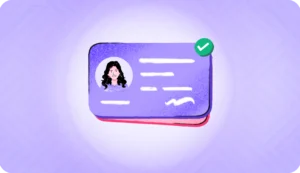A few years ago, customers had to stand in line, fill out a lengthy form, and wait several days to open a bank account.
Fast forward to today, most private banks have opted for digital onboarding and so have other companies in all domains, including insurance, broking, healthcare, medicine, tech, marketing, etc. The entire offline process has now been reduced to an online, convenient, and fast system.
Customers can get digitally onboarded with stock broking firms, insurance companies, tech companies, and medical firms and get their bank accounts opened within a day or even in a few hours.
Want to implement a similar system in your business? Read along. This blog talks about everything from what digital onboarding is, its types, challenges that come along, and the benefits it offers to businesses.
What Is Digital Onboarding?
Generally, onboarding or customer onboarding is the process of integrating a customer into an organisation and enabling them to use a company’s products or services.
The traditional process involves physically visiting the organisation’s location (bank), standing in queues, filling out forms, and manual verification.
When the onboarding is done remotely using a mobile device like a smartphone or laptop without talking to a sales rep or submitting any physical paperwork, it’s termed digital onboarding.
What Is The Digital Onboarding Process?
While the exact process of digital onboarding varies from organisation to organisation, the general concept remains the same.
The organisation doing the digital onboarding uses a 3rd party or their platform and walks the customer through it.
Earlier, an email ID and mobile number were enough for digital onboarding. However, with the rise of fraudulent cases, several extra layers of security have been added. The customer must fill out a short online form and upload the required documents, such as a driving license, and passport, which are verified against official government records to ensure the correct identity.
While the above may seem a little daunting, it’s way better and requires less effort than the traditional manual onboarding method.
Additional Types of Onboarding
1. On-Site Onboarding
This is a conventional onboarding method that requires the customer’s physical presence. The customer must visit the office or the company’s store to learn more about the product/service.
Also, the customer must provide personal information, fill out forms manually or even visit the physical office multiple times. And this is what makes the onboarding experience a hassle for the customer.
2. Digital Onboarding
As stated earlier, digital onboarding doesn’t require the customer to be physically present, stand in ques, or fill out forms manually using a pen and paper. Digital onboarding can be done regardless of where the customer lives. All he needs is an internet connection and a mobile device like a laptop or a smartphone.
3. Semi-On-Site Onboarding
This one is the combination of the above two types. Half of the process takes place on-site, i.e., at the company’s office, and the rest of the process takes place digitally regardless of the location.
For instance, if a customer is called at the company’s office just to signup for the service and the forms to be filled are sent in a digital format which the customer can fill whenever and from wherever he wants, it’s termed semi-on-site onboarding.
What Are Digital Onboarding Benefits?
1. Client-Focussed Approach
The regular onboarding procedure is long, complex, and requires a lot of effort from the customer’s end. And this can sometimes frustrate the customers, forcing them to switch to other businesses.
However, fortunately, digital onboarding solves this issue. Digital onboarding allows the customer to choose the time and place at their convenience. And doing this creates a positive relationship between the business and the customer, motivating them to purchase more.
2. Uninterrupted Operations
Several companies realised the true benefit of digital onboarding during the COVID-19 lockdown.
Most companies who followed an offline customer onboarding system incurred huge losses and couldn’t call customers to their offices and onboard them. On the other hand, companies that opted for digital onboarding brought in more customers and survived all the lockdowns.
Companies that follow digital onboarding can help onboard new customers and continue their operations regardless of the circumstances.
3. Convenient
Digital onboarding makes the entire onboarding process seamless and convenient. All the customer has to do is enter the information digitally using their phone or laptop, verify, and they’re done.
4. Quick
The traditional onboarding process involves the customers going back and forth multiple times to ensure they’re doing it right. And this can make the entire process long. However, in digital onboarding, a business can offer quick support to customers, significantly reducing the time to onboard them.
Challenges of Digital Onboarding
Digital onboarding also brings several challenges, such as:
1. Friction
If businesses, especially banks, ask for too much information, it could create friction, and the customer might get irritated. Therefore, companies must ask for limited information, and a system should be in place that auto-fills data from ID proofs to save customers’ time and effort.
2. Security
Security is a big concern when it comes to digital onboarding. Therefore, companies must implement stringent security measures and comply with KYC AML regulations to keep frauds at bay.
3. Personal Touch
It’s pretty hard for businesses to keep the customer entertained without including an actual human in the process. However, businesses can deal with it by adding personalised messages like “your payment is being processed” instead of “processing.”
4. Regular Technology updates
Digital onboarding entirely relies on technology that updates every few days. And if the businesses do not update in synchrony, it could lead to technology stagnation which might portray the business negatively.
How Is Identity Verification Vital for Digital Onboarding?
Digital onboarding is undoubtedly a convenient procedure for both the company and the customers. Unfortunately, it also brings a risk of fraud.
For instance, someone else could participate in the onboarding process on their behalf instead of the customer. And the other person might use the actual customer’s account for illegal purposes.
However, that’s when identity verification comes into the picture. Using identity verification, companies can ensure that the customer is exactly who they claim to be, thus reducing the risk of fraud to a minimum.
Here’s what companies can use:
- Facial biometrics: facial biometrics can be used to verify a customer’s identity. Using liveness detection, companies can determine whether the picture was taken in real-time or not.
- Document verification tools: Such tools automatically read the data on a document, such as the PAN number on a pan card or passport number on a passport. And this makes it easy for companies to verify the data against government records.
- Photo Assistance: When taking pictures, customers sometimes click blurry photographs or the ones that are out of focus. However, with photo assistance that uses AI, customers can be directed to click just the right image for ID verification.
Conclusion
Digital onboarding is a must-have for every business, regardless of the domain. After all, it benefits not only the customers but the businesses as well. However, while upgrading to digital onboarding, businesses must deal with the challenges it brings along. This will enable them to use digital onboarding in their favour.
FAQs
What is digital onboarding?
Digital onboarding is the process of introducing a customer to a company’s products and services remotely using mobile devices.
Is digital onboarding safe?
Yes, digital onboarding is generally safe, provided the bank or the organization is complying with the KYC and AML regulations at all times.
How to make digital onboarding convenient for the customer?
Here’s how: 1. Creating brief online forms. 2. Adding a personal touch to the entire procedure. 3. Cut short the whole process. 4. Offering 24/ customer support if the customer gets stuck.
Is digital onboarding effective?
Yes, digital onboarding is effective both from the perspective of the company and the customer.





